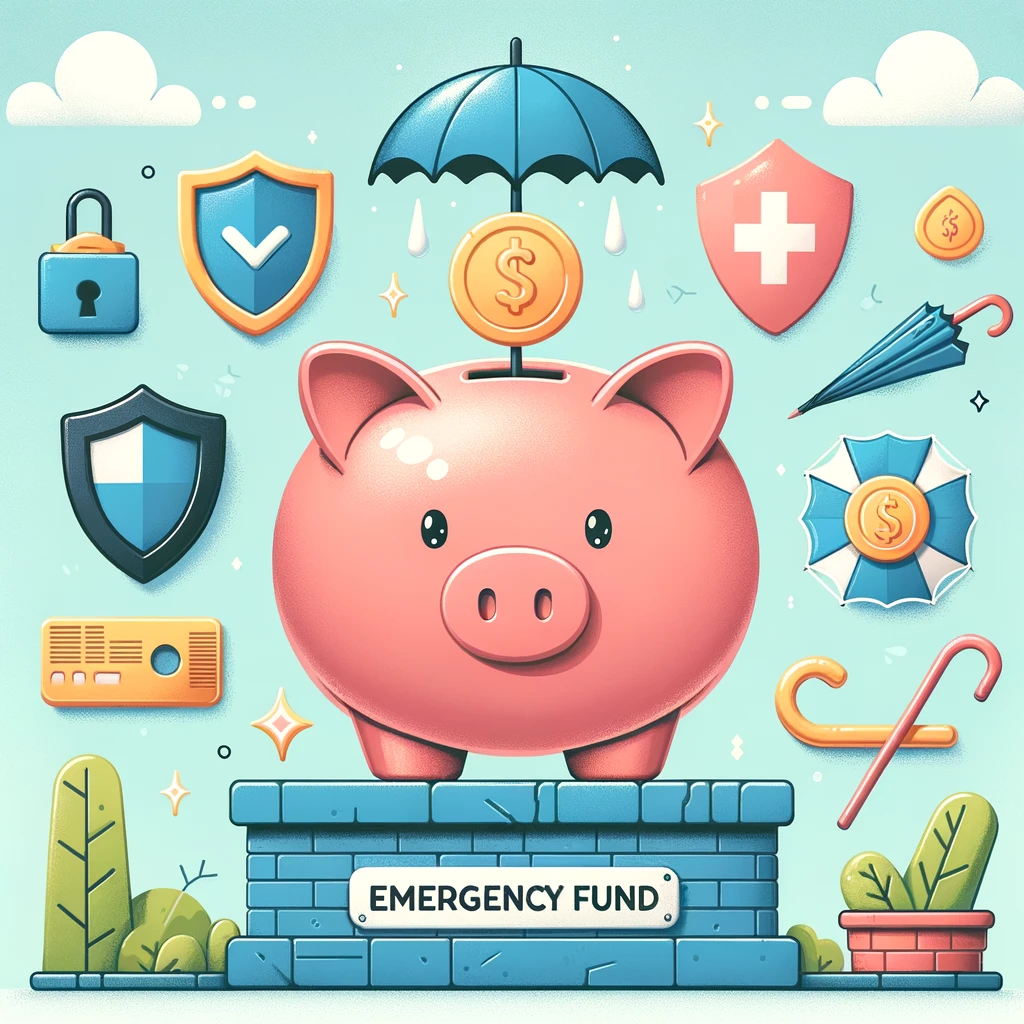Introduction
In the current volatile financial climate, possessing a financial buffer is essential, far beyond a mere convenience. This buffer, or emergency fund, provides the resilience needed to weather financial emergencies. From abrupt employment changes and medical emergencies to necessary home maintenance, life’s unforeseen events often carry significant financial burdens. Recognizing the value of initiating an emergency fund is crucial. It stands as your primary safeguard against life’s financial uncertainties, ensuring your financial plans remain intact regardless of the challenges encountered. This guide will explore the vital steps and tactics for establishing an emergency fund, underscoring its role in protecting your financial well-being. Learning to set up an emergency fund effectively arms you with the tools for a more financially secure future for you and your family.
Understanding an Emergency Fund
Essentially, an emergency fund serves as a safeguard to assist you in handling unforeseen financial difficulties, ensuring these challenges don’t compromise your long-term financial objectives or lead you into debt. This fund is essentially a reserved amount of money intended to manage abrupt costs, including medical expenses, vehicle maintenance, or daily living costs during times of unemployment. But what’s the process to initiate such an important savings endeavor? Learning to establish an emergency fund marks the initial move toward creating this critical aspect of financial protection.
The Definition and Purpose of an Emergency Fund
An emergency fund goes beyond a simple savings account; it acts as a crucial financial buffer for unexpected situations. Its main role is to ensure you have quick access to cash when unforeseen financial needs arise. This helps avoid dependence on credit cards or loans that could worsen your finances with their high interest rates and challenging repayment conditions. The sense of security and calm that an emergency fund brings is priceless, providing you the strength to tackle financial surprises head-on.
How an Emergency Fund Offers Financial Security and Peace of Mind
Starting an emergency fund is essentially about protecting your financial health. By setting up this safety cushion, you ensure that you’re prepared to handle sudden costs without throwing off your budget or derailing savings for future objectives, like retirement or buying a home. It’s about establishing a financial buffer that shields your financial strategy from unforeseen occurrences, thereby lessening the worry and stress money emergencies often bring.
Starting an emergency fund can feel overwhelming, particularly if you’re beginning with nothing. The important strategy is to start with small amounts and remain steady in your efforts. A small emergency fund can still offer a considerable feeling of stability and calm. As you keep adding to your fund, you’ll discover that this financial buffer provides both tangible and psychological advantages. It gives you the confidence of having the means to manage unexpected events, enabling you to concentrate on your future financial objectives with clarity and confidence.
Fundamentally, understanding how to set up an emergency fund is akin to investing in your financial well-being and future security. Grasping what an emergency fund is, along with its importance, and acknowledging its significant role in bolstering your financial safety, is a vital move toward achieving a more secure and assured financial existence.
Determining Your Emergency Fund Goal
When embarking on the journey of financial preparedness, one of the first steps is to define a clear target for your emergency fund. Understanding how to start an emergency fund involves not just the act of saving, but also setting a goal that aligns with your unique financial situation and needs. This goal acts as your financial beacon, guiding your saving efforts and providing a clear endpoint to strive for.
Calculating the Ideal Size of Your Emergency Fund
The amount in your emergency fund should match the monthly expenses of you or your household, ensuring you have sufficient resources to manage these costs for a specific duration, usually between three to six months. Begin by figuring out your average monthly expenses, which should account for housing payments like rent or mortgage, utility bills, food costs, insurance fees, and any other regular expenses. After pinpointing your average monthly expenditure, multiply that by the desired number of months you wish for your fund to sustain you. This result will provide you with a goal sum, aiming to support you financially during times of unexpected income disruption or significant unforeseen expenses.
Setting Realistic Goals
It’s vital to customize your emergency fund goal based on your unique situation. Consider key elements like the stability of your employment, whether you have dependents, and your existing financial commitments to decide how much you need to save. For instance, individuals in households with two stable incomes might opt for a smaller fund, while those who are self-employed or the primary providers for their families may need a larger safety net.
Setting a feasible objective also involves assessing your ability to save at the moment. If the idea of setting aside three to six months’ worth of living expenses feels overwhelming, begin with a modest goal, perhaps $1,000, and elevate your target as your financial health betters. The crucial part is to start—initiating your savings brings you closer to having that financial cushion for comfort and stability.
As you figure out the steps to establish an emergency fund, keep in mind that your target may evolve. Life events, such as landing a new job, relocating, or changes in family dynamics, might prompt a reassessment of your emergency fund’s size. Periodically review and adjust your savings goal to ensure it matches your current lifestyle and financial needs, maintaining adequate coverage for unforeseen challenges.
Steps to Start Your Emergency Fund
Starting on the journey towards financial stability is about more than just grasping the fundamentals; it’s about taking concrete actions to develop a solid emergency fund. Learning the process of setting up an emergency fund is crucial, as it sets the stage for financial safety, allowing you to handle life’s surprises with assurance. We’ll dive into the actionable measures to kickstart your emergency fund.
Step 1: Assess Your Financial Situation
Initiating your emergency fund begins with a comprehensive review of your present financial status. This step requires you to assess your regular income, examine any debts, and carefully review your monthly spending. It’s vital to comprehend the flow of your finances — both incoming and outgoing. Doing so helps pinpoint areas where you can save more and spots where expenses might be trimmed down. Gaining a detailed understanding of your financial landscape aids in establishing achievable savings targets and devising a savings strategy that fits your financial ability.
Step 2: Setting Up a Dedicated Savings Account
After understanding your financial situation, the following move is to set up a specific savings account intended for your emergency funds. It’s important to keep this account distinct from your usual checking or savings accounts to avoid using it for everyday expenses. In selecting an account, think about how easily you can access your money, any limitations on withdrawals, and the interest it earns. You’re looking for an account that provides some interest earnings while ensuring your money is accessible when needed for urgent situations.
Step 3: Creating a Budget for Savings
Once you’ve established your emergency fund account, the next step is to formulate a budget that dedicates a segment of your earnings towards savings. Budgeting acts as an effective strategy for organizing your financial life, allowing you to prioritize your expenditures. Begin by enumerating every source of income and all your monthly costs, then figure out a feasible amount to earmark for your emergency fund regularly. Remember, even minor deposits can accumulate gradually, so starting with a smaller sum is perfectly fine.
Step 4: Automating Your Savings
Automating your savings is a highly effective method for enhancing your emergency fund. By arranging for automatic transfers from your checking to your emergency savings account, you ensure regular contributions are made effortlessly each month. This strategy not only streamlines the process but also reduces the likelihood of missing deposits, keeping you on track with your financial objectives.
Getting a handle on starting an emergency fund and actively working towards it are vital steps in prudent financial management. Evaluating your financial status, opening a specific savings account for emergencies, setting a budget, and automating your deposits will significantly aid in developing a financial buffer to safeguard against unforeseen financial challenges.
Tips for Building Your Emergency Fund Quickly
Once you have laid the groundwork for your emergency fund, the next crucial step is to strategize how to grow it efficiently. Knowing how to start an emergency fund is just the beginning; the speed at which you can build it to your target amount can significantly impact your financial resilience. Here, we’ll explore actionable tips to accelerate the growth of your emergency fund, ensuring you’re prepared for life’s unexpected turns sooner rather than later.
Finding Extra Money to Save
To swiftly bolster your emergency fund, adopting a smart financial strategy is key. Begin by evaluating your spending, pinpointing opportunities to reduce spendings on non-essential items. Consider eating at home more, ending subscriptions you don’t use, or choosing less expensive leisure activities. Moving the funds saved from these cutbacks into your emergency savings can greatly increase its size.
Furthermore, engaging in additional work, such as part-time jobs or freelance gigs, can be beneficial. The gig economy presents various ways to make extra money, including driving for a rideshare service or offering freelance services in writing or design. Directing this extra income to your emergency fund not only speeds up its growth but also broadens your financial safety net.
Another quick method to enhance your emergency savings is by selling items that are no longer useful to you. Utilizing online platforms and local sales apps to sell unused belongings can efficiently convert them into cash, significantly contributing to your savings target.
Reviewing and Adjusting Contributions
As your financial circumstances change, so too should your method for accumulating your emergency savings. It’s vital to frequently examine your budget and progress in savings to grasp how to effectively commence an emergency savings plan. Should you gain a salary increase, a bonus, or encounter any surprise financial windfalls, think about boosting your emergency savings contributions. Minor increases, such as an extra $20 or $50 each month, can significantly impact over time.
Similarly, in times of financial difficulties, tailor your savings contributions as needed. The importance lies in maintaining contributions to your emergency savings, even if the amount is less than initially intended. Consistency is key in nurturing your emergency savings, ensuring it develops into a substantial safety net gradually.
Embracing flexibility and the willingness to adapt are crucial when learning to quickly establish an emergency savings fund. Through proactive efforts to identify more saving opportunities and continuous review and modification of your saving tactics, you can achieve your emergency savings goals more promptly. This approach not only offers mental comfort but also fortifies your overall financial security, readying you for any future obstacles.
Overcoming Challenges in Building an Emergency Fund
While grasping the basics of initiating an emergency fund is an essential initial move, the journey towards reaching your savings target frequently encounters obstacles. Many individuals face obstacles such as a low income, high monthly expenses, or unexpected financial setbacks. However, with determination and strategic planning, these hurdles can be navigated successfully, ensuring your journey towards financial preparedness remains on track.
Navigating Low Income and High Expenses
A frequent obstacle when setting aside money for an emergency fund is finding ways to save when your earnings just meet your basic needs. The strategy here is to begin with whatever small amount you can manage, emphasizing regular saving. Even putting aside as little as $5 or $10 from each paycheck lays the groundwork for this fund. As you fine-tune your budget or enhance your earnings, you have the opportunity to slowly augment these savings.
Reevaluating your spending to distinguish between necessities and non-essentials is another effective approach. At times, cutting back on discretionary expenses can generate extra cash that you can allocate to your emergency reserves. Furthermore, seeking additional income sources, like developing skills for a better-paying position or taking on side jobs, can significantly contribute to bolstering your emergency savings.
Staying Committed to Your Emergency Fund Goal
Creating an emergency fund is more of a long journey than a quick dash. It demands perseverance, self-control, and a dedicated pledge to your financial health. To keep yourself on track, establish small, realistic goals and take time to celebrate your achievements. These small victories can act as positive reinforcement, reminding you of the progress you’re making and underscoring the importance of maintaining an emergency fund.
Imagining the sense of stability and reassurance your emergency fund will offer is another strong incentive. Think about possible financial crises that could occur and how having this safety net could affect your response to these challenges. This thought process can underscore the significance of your savings efforts and help maintain focus on your objective.
Additionally, sharing your aim with someone close to you can provide extra encouragement and a sense of responsibility. Often, simply knowing that someone else is aware of your ambitions can bolster your drive to fulfill them.
Mastering the steps to initiate an emergency fund and navigating through the hurdles it presents is a reflection of your resolve to protect your financial future. While you may encounter setbacks, they can be overcome. Through strategic planning, steadfastness, and an optimistic attitude, you can establish an emergency fund that ensures financial stability and serenity for the foreseeable future.
Conclusion
Learning the process of creating an emergency fund is a crucial move towards achieving financial steadiness and tranquility. By establishing attainable savings targets, making thoughtful choices on reducing costs or boosting earnings, and adhering to your strategy, you can develop a protective buffer for yourself and your family against unexpected financial difficulties. Embarking on the path to a substantial emergency fund might present hurdles, yet the reassurance it offers is priceless. Initiate this journey now, laying the foundation for a financially secure tomorrow. Bear in mind, the optimal moment to commence your emergency fund was in the past; the second-best moment is the present.



